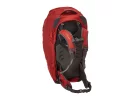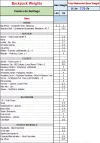I trust you meant kg and not gm for the pack weight.
Almost every item on your list I have - same quantity but at nearly twice the weight in almost every case. Maybe because I wear XL? I'm going to have to get much more serious about both my weight and the weight of my gear!! No surprise here - lightweight gear costs much more! For instance - what knife did you carry? My Swiss Army knife (one with scissors for cutting moleskin and an all-important cork screw!) comes in at 5 oz - double your weight.
About the only thing I carried you didn't mention was shower shoes and I'm actually going to go UP in weight and take sandals that I can hike in if necessary. I watched one gal walk the CF for two days in flip flops while she was nursing some awesome blisters; I've decided my sandals can double as shower shoes as needed and are worth the added pound to have them as backups to my shoes.
It also looks like your list doesn't include things you wear or carry in your pockets (e.g. t-shirt, phone, wallet, passport?). Correct? Leading to -- Did you hike the Camino in shorts or pants (didn't notice pants in the pack)? Do you hike in the bike shorts? Other than two pair of bike shorts, am I reading it right - no spare shorts/pants at all?
Finally - despite weighing every individual item, after putting it all in my pack the total weight comes out almost 15% higher than my spreadsheet total. Gremlins!!
Thanks - and yup, I've become a gram weenie!!
Yup, kg, not gm... thanks for the correction.

So, are you using the same brands and models of all the items I listed? Because that makes a big difference in weight savings. I do a lot of backpacking every year... hundreds of miles on the trail each season. Many thousands of miles overall, including several thru-hikes like the PCT.
When my investment in ultralight gear (which does mean more cash spent at the outset) is broken down to its cost per mile of trail hiked, the cost is actually pretty small. I look at the investment in two ways:
1. The gear lasts a long time because I make sure that the quality of its construction is up to my standards. As someone who is hired by various manufacturers to test the quality of various types of backpacking equipment and clothing, I have a good comfort level on what to look for in this regard. But there are a lot of published gear reviews by those who actually are backpackers (it is surprising the number of reviews that are published by those who don't do a lot of actual backpacking), and there are a few good hiking and backpacking forums. Those who want to spend the time researching can make good and informed decisions when getting ready to spend money for gear or clothing.
2. If I am wanting to get as much enjoyment out of my backpacking experience as possible, it becomes essential for me to have as light a load as possible. When I think of taking each step as I'm hiking, I think of it as a 'rep' at lifting a weight.... the same way I would think in terms of working out with weights at a gym; each workout is based on how many repetitions one does at a specific weight on a machine or a free-weight device like a barbell.
Each step I take is under load; that load is my own weight plus the weight I have on my back. Add up the number of steps one takes during a day of backpacking, multiply that by the number of pounds one is carrying, and it quickly becomes apparent why I will spend the difference in the cost of a piece of gear that is lighter.
On average, 10,000 steps equal 5 miles. For 25 miles -- which is about my average miles per day + or - on Camino, that is 50,000 steps. Carrying an 8 pound (4 kg) pack, that means I've lifted 400,000 pounds (181,437 kg) of backpack weight at the end of each day. With a 15 pound pack (7 kg), that would be 750,000 pounds (340,194 kg). Now multiply that by the number of days out on Camino. Say 32 days.
An 8 pound (4 kg) pack, the cumulative total is
in pounds, 12,800,000
In kilograms, 5,805,982
A 15 pound (7 kg) pack, the cumulative total is
In pounds, 24,000,000.
In kilograms, 10,866,217
As far as weight goes for an individual piece of clothing, yes, the size of the clothing will affect its weight.
No, I don't take shower shoes. Yes, showers can be dirty, if they are that dirty I wear a pair of socks. As to exposure to fungus, like athletes foot, current medical research shows that since the spray and splash of water from the floor of the shower can throw the contaminants onto the feet, flip flops make little difference as to prevention of athletes foot. What
does make a difference is wiping one's feet with a mild antiseptic after the shower; for this I have medicated wet wipes.
I don't do backups for shoes. Maybe because of my experience, I do not carry things on Camino 'just in case'. My shoes will perform as well on Camino as they do when I workout with them home. If I use a pair of shoes which create problems while at home, out they go.
IF I were to run into any kind of problem on Camino, whether it be shoes or the need for more Leukotape, I would simply pick it up at a shop along the Way.
My knife is a small Opinel, which is a lot lighter than even the smallest Swiss Army style knife with scissors and corkscrew. I don't drink alcohol, so a corkscrew is useless to me

, and my knife and the scalpel blade in my first aid kit will, between them, cut sausages, cheese, and moleskin just fine

My total pack weight does not include the weight of anything that is not in my pack. Things like ID, cash, phone stay in an accessory pouch around my neck.
I don't take T-shirts. Only the long sleeved shirts on my list. They keep me cool in the hot sun by keeping the sun's radiant energy from touching skin, which makes one get and feel hotter (look at how desert dwellers dress for heat), keeps me from sunburn, and if it ever is chilly, provides plenty of warmth when use with my insulating and outer layers.
No, no long pants. I always hike in shorts. And I don't use biking shorts; I use lightweight synthetic (nylon) shorts with an inner liner for the boys. With two pairs of shorts, I have a spare since I can only wear one pair at a time

My spreadsheet total of each item which has been separately weighed, matches my separately weighed fully loaded pack. I have a professional baker's scale that I use which is calibrated using two commercially purchased calibration weights: a 100 gram weight, which is then double checked for accuracy using a 3 kilogram weight.
I have to have this kind of scale, and its accuracy, for the gear testing that I am hired to do. It helps me keep the honesty in the specifications the manufacturers list.

What I am doing for this Camino is dropping a few items and modifying some others. I have dropped the weight of my Mariposa backpack by 6 ounces; I am not taking a spoon; the Aqua Mira is dropped; I have switched collapsible water bottles for something that is just as light but could also double as an effective filtration against pathogens and parasites; my medications are different and half the weight now; the shemaugh is dropped and the new towel is half the weight; a new headlamp is two ounces lighter than the old one; a new Enlightened Equipment sleeping quilt is now 8 ounces instead of 14 ounces. And there are a couple of minor modifications here and there on pieces of gear.
HOWEVER.... my pack won't be any lighter, and will go up in weight by 16 more ounces, because I am adding a GoPro Black Hero 6 to the mix. Some of the GoPro stuff will get mailed home once I get past Roncesvalles, like extra batteries, which will drop the extra weight by 6 ounces. And I am doing a lot of pondering and head scratching to see where else I can offset the weight increase. And no, my iPhone can't replace the GoPro, because of the sheer amount of video storage needed and the fact I will be recording in 4K resolution.
Such is life. Maybe I'll just carry a bit less water




























